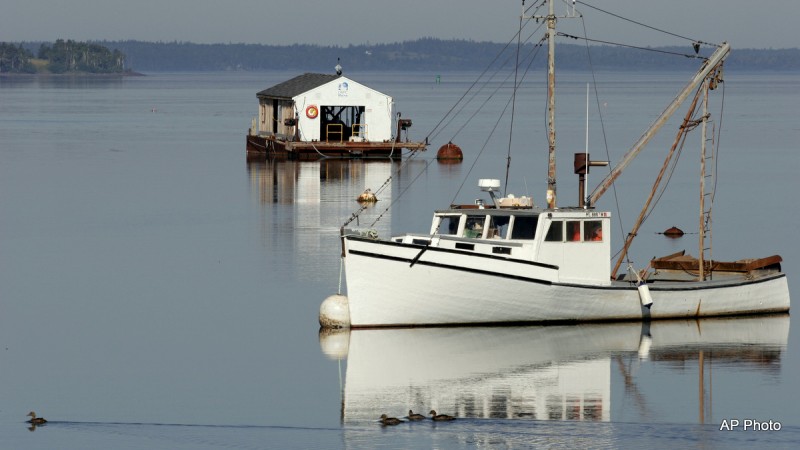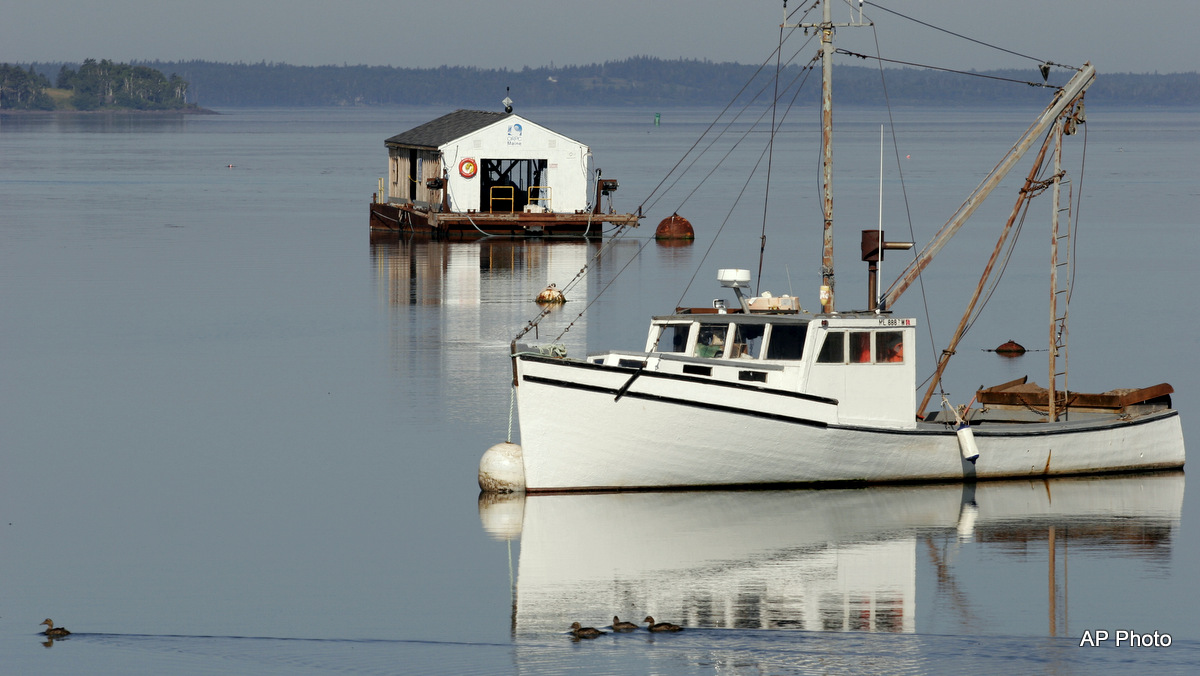
PEMBROKE, Maine — Halcyon Tidal Power has chosen the Pennamaquan Estuary in Maine as the site of a first-of-its-kind project to harness the power of ocean tides. The project could bring long-term job opportunities and green energy to towns in the immediate coastal area, but residents are concerned about how it could affect the local fishery industry that many rely on for their livelihoods.
As climate change ushers in record temperatures, as well as storms and tornadoes, obliterating natural habitats, turning oceans lifeless and threatening the existence of entire species, Halcyon says the new design represents a way to harness energy that is viable on five continents.
“Tidal range power is an energy resource available on a massive scale for global reduction in carbon emissions; and with Halcyon’s low cost construction methodology and environmentally pro-active design, this resource can be realized at its full potential,” the company says.
Pembroke residents haven’t quite jumped on board yet. They have filled the town hall to capacity for the public hearings that Halcyon is required to hold as part of the Federal Energy Regulatory Commission’s permitting process.
Milan Jamieson, a member of the town’s Board of Selectmen, who says he’s neutral on the issue, describes the town hearings as a mix of people both for the project and against it.
“The people who have lived here all their lives tend to be for the change, asking about jobs and income,” Jamieson told MintPress News.
Dr. Robin Hadlock Seeley, a marine biologist and resident of Pembroke, expressed doubt that the “barrage,” as the project is known, is any different than a dam. Seeley serves as Cornell Academic Coordinator for the Shoals Marine Laboratory, operated by Cornell University and University of New Hampshire.
She and other local residents are concerned that the delicate marine ecosystem of Cobscook Bay will be irrevocably harmed and the species which travel back and forth between the bay and the basin at the mouth of the Pennamaquan River will also be threatened by the proposed Pennamaquan Tidal Power Plant.
“Can scallops get through there? Absolutely not!” said Julie Keene, a resident of a nearby town.
Keene’s family has fished the waters of Cobscook Bay for generations. “I’m an elver fisherman. There’s no way that eels will dive down to go through. And the lobsters that are up there. And the crabs that are up there. You know, the clam flats. Are they going to be smothered by the silt?”
Residents have also raised concerns about how industrial noise underwater will affect marine life, in addition to presenting queries about seaweed, invasive species, kayak and canoe access, lobsters and clamming, and asking questions about the potential impact on property values. All of these questions and concerns are bolstered by the fact that, as Dr. Seeley pointed out at one of the hearings, this project is experimental and has no precedent.
Like Keene, many residents depend on seasonal fishing and clamming, so this experimental project could represent a gamble they simply can’t afford to lose.
Is it different from a dam?
Dams have historically disrupted the natural tidal cycles and reduced the flow of seawater into and out of a basin, adversely affecting the marine environment. The reduction in flow to the shoreline is critical for a diverse population of fish nurseries, hundreds of different invertebrates that burrow in the mud, shellfish and birds that feed on the mud-flats. Many of these intertidal zones are now protected by the RAMSAR Convention on Wetlands.
Conventional dam designs also increase the time that water is held in the basin, resulting in siltation and increased algal blooms and nitrates which are sometimes toxic.
The new technologies were developed by Halcyon Marine’s founder, physicist Ramez Atiya, and are patented in the United States, China, Mexico and the Russian Federation.
“It’s an interesting new technology,” Andrew Landry, an attorney for Halcyon based in Portland, Maine, told MintPress. “There are two patents — one for construction and one for operating.”
The barrage consists of concrete panels dropped between pile-ons. There is no need to flatten the bottom of an estuary, which Landry says is the most expensive aspect of current designs.
“Typically, on the inner side of the construction, tides don’t get as high or low, so it disrupts the marine cycles,” he said. “This uses turbines acting as pumps to get the same level of high and low tides. It minimizes the impact on the marine ecosystem.”
This would be the first project to combine these two elements, he said.
Further, the project would generate permanent job opportunities, as it will require around-the-clock staff and maintenance operations. Listed as personal property, the tax dollars the project would generate are also expected to contribute significantly to the town’s public safety and education sectors.
“It would bring in about $800,000 in tax,” Jamieson, the member of the Board of Selectmen, said. “Sixty-five percent of our tax bill goes to education. This could go a long way to help our schools, our road maintenance, our fire department.”
Preserving the natural ebb and flow
The Pennamaquan Tidal Power Plant would be the centerpiece of a 1,616-foot tidal low dam stretching across the point where the Pennamaquan River flows into Cobscook Bay.
Seawater would pass back and forth like flood and ebb tides through the tidal power plant, a process facilitated by tidal wing technology. Additional pumping during slack tides keeps the tidal rhythms rising and falling in their natural 12- to 26-foot rhythms and the intertidal zone is preserved.
The result generates a cycle that closely preserves the natural ebb and flow of the tides, floods the intertidal zones to their natural levels, eliminates sedimentation, and maintains natural residence times, according to Halcyon.
“This is a technology that could be employed on a massive scale where the conditions are right, such as Korea, China, Germany, India and Great Britain,” Landry said. “It could easily be adapted to a large or small project.”
Further, Halcyon claims that by reducing the number of blades and lowering their speeds, the barrage “reduces the risk of physical fish strikes by the turbine blades, as well as damage to fish bladders due to significant changes in water pressure gradients caused by high impeller speeds.”
Smaller turbines also further reduce fish mortality because the blade tip spins more slowly than a larger turbine. The leading edges of the blades have been significantly thickened and should permit fish to slide off the impeller blades.
Conventional construction methods require massive underwater structures to support tidal loads. Seafloor modifications required for the Halcyon project are negligible, Landry says. By providing piling support, the Halcyon project is lighter and smaller than a conventional powerhouse.
A Halcyon Tidal Power Plant has an estimated economic life of over 120 years. After that, it can be decommissioned by floating the equipment up to the surface and towing it away. Unlike projects that require permanent structures like embankments, once the plant is decommissioned, Halcyon says it leaves behind virtually no traces.
Passamaquoddy Tribe at Pleasant Point
The estuary is named Pennamaquan from “Penomahqank” or “Nimonahqanok,” which translates as “at the place where maple sap is gathered” in the Passamaquoddy/Maliseet language.
The Passamaquoddy people, also known as Sipayik (“along the edge”) have inhabited this part of Maine’s Downeast region and maritime Canada for thousands of years and have a strong relationship to the land. The balance for needed economic development and long-term environmental preservation is the focus of the tribe’s environmental program.
In an Oct. 17 letter to Kimberly D. Bose, secretary of the Federal Energy Regulatory Commission, regarding the Pennamaquan Tidal Power Project (P-13884), the National Oceanic and Atmospheric Administration’s request for revisions said the plan “includes only the State of Maine in the resource management goals. However, other federal, state, and Tribal resource management goals are relevant.”
“We’re talking about a dam that has the potential to hurt the ecosystem,” said Ed Bassett, Passamaquoddy environmental technician, to MintPress.
Bassett explained the life cycles of the elvers, born in the saltwater of the Sargasso Sea. To maintain their presence in creation, millions of these eels swim to their place of birth — the Sargasso Sea — to spawn and die. Their pathway is unknown. They navigate through the dark, using magnetism, moonlight and stars as their guides.
The eggs hatch into willow leaf-shaped larvae that find ocean currents to move them toward the Pennamaquan River. They grow into 5-inch elvers swimming into the estuaries, and during flood events they become yellow eels — sometimes growing more than 4-feet-long. They can spend some 30 years in a watershed before the Sargasso beckons to them. Then, they turn from yellow to a blackish-bronze and return to the sea from whence they came.
“They have one chance to produce offspring,” Bassett said. “We’d have a structure that wouldn’t allow them to pass up and down the river. Dams have been documented to have killed millions of eels.”
Unable to pass through the blades of the turbines as they migrate, eels have been chopped to bits and seen floating on rivers in areas where dams were built. As eel populations dwindled and disappeared, so did the related traditions and customs of communities that long relied on them.
Yet eels aren’t the only marine life affected by damming, as harbor seals are also known to bring their young into the estuary.
“The mother seal leaves her young on a protected ledge while the adults forage for food,” Bassett said. “The dam would cover that ledge.”
The 115-acre Pleasant Point Reservation, one of two Passamaquoddy communities in Maine, is located about 6 miles from the river. The reserve is bordered on its north side by Passamaquoddy Bay and on its south side by Cobscook Bay. These two bays are part of the Passamaquoddy’s traditional fishing grounds.
“The area they’re proposing to impound is one of the richest areas in the bay,” Normand Laberge, an engineer and director of the Halcyon project for the Passamaquoddy, told MintPress. “Salmon and sturgeon are of concern. Whales and porpoises are in the area. That has to be addressed.”
“The ability of fish to migrate in and out is one of the things we’ll look at for the best way to ensure this,” Landry, the Halcyon attorney, said.
Unlike wind, the tides are a dependable and predictable source of renewable energy, Laberge says, noting that the mouth of the river was chosen for the barrage because it provides a fairly narrow opening that a dam can be built across.
“There are designs that use turbines without dams, like the tide mills of the old days that drove water mills, but engineering-wise, these are more expensive and don’t produce much energy,” he said. “Projects put devices at the bottom of the ocean and it’s hard to maintain.”
Halcyon has hired environmentalists to conduct more than 40 studies, examining all of the project’s potential risks. Those studies will begin later this year and continue for up to two years to include an entire cycle of seasons. Landry says the process to gain a license from FERC takes about six years, and Halcyon is two years into the process.


